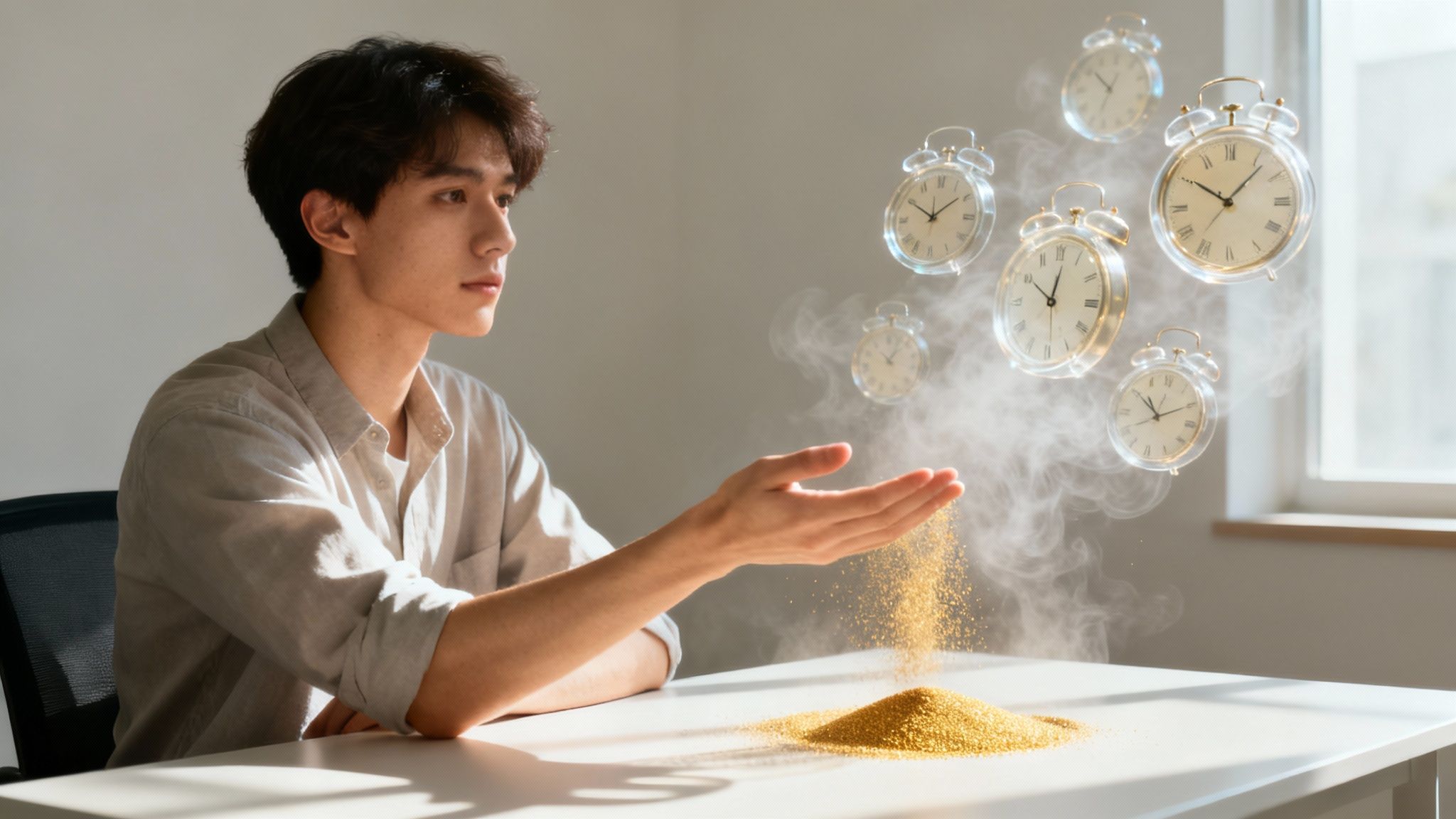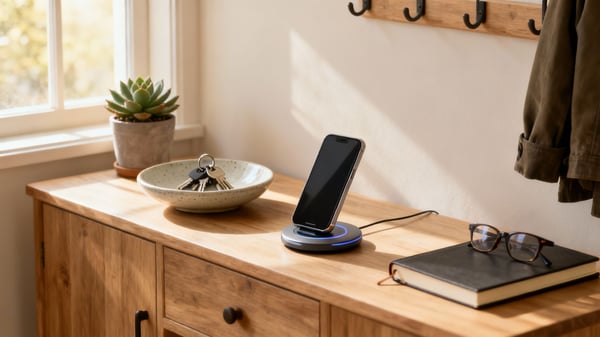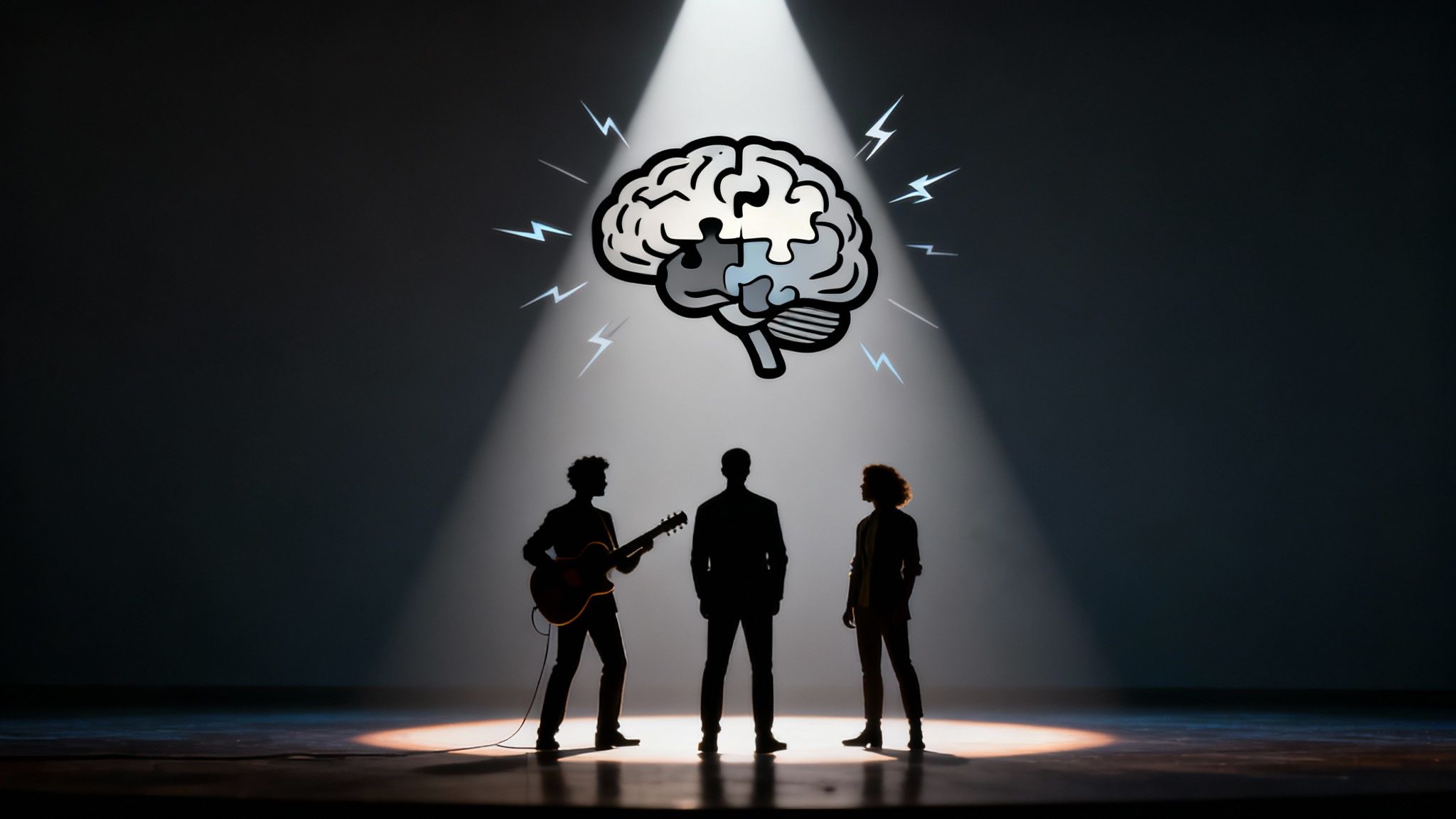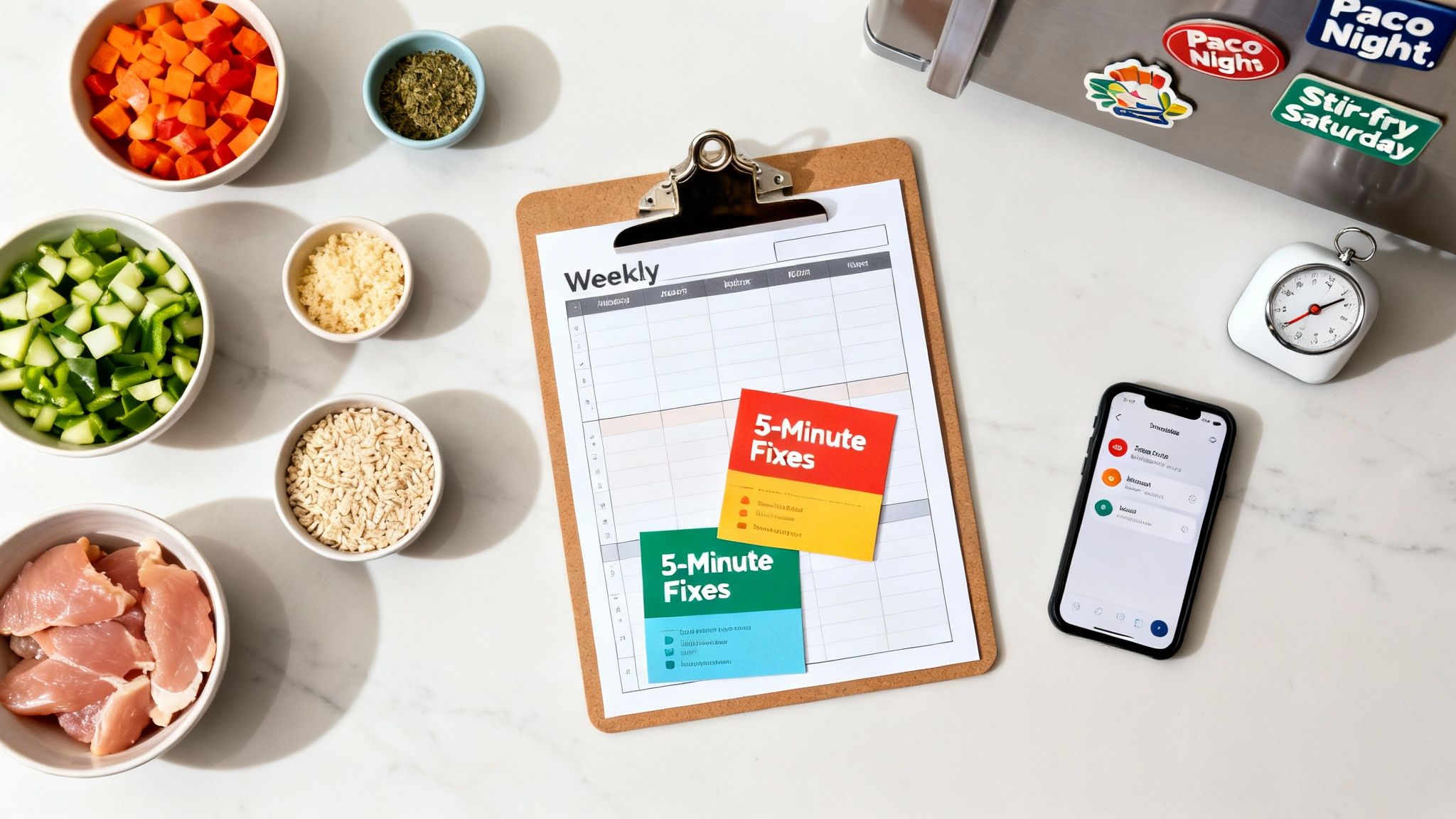"Where did I put my keys?" If that question feels like a daily mantra, you’re in the right place. The fastest way to stop losing things is to give every essential item a dedicated, consistent "home" and build a routine around putting it back. This simple system takes the pressure off your memory and lets habits do the heavy lifting, saving you from that frantic daily search.
This guide will help you understand the brain science behind why we lose things and give you practical, compassionate strategies that actually work.
Why You Keep Losing Your Things (It's Not a Flaw, It's Brain Science)
It always starts with that familiar surge of panic. Your phone has vanished, your keys are hiding again, and that important paper seems to have just evaporated. If you recognize yourself in this pattern, you’re not alone—and it is absolutely not a character flaw.
This constant cycle of losing and searching is exhausting, but it’s often a symptom of how your brain is wired, not a personal failing.
Your Brain's Filing System is Overwhelmed
Think of your brain as a busy office assistant trying to file incoming information. When you’re calm and focused, the assistant carefully labels a file—"keys on kitchen counter"—and puts it neatly in the right cabinet. Easy.
But when you’re rushed, distracted, or juggling a dozen thoughts at once? It’s like ten people shouting instructions at the same time. In that chaos, the "keys" file gets tossed onto a massive, unsorted pile. It isn't lost, but good luck finding it later. For many of us, especially those with ADHD, life often feels like that chaotic office. This happens because of challenges with a few key brain processes:
- Working Memory: This is your brain’s temporary sticky note. It holds information like, "I put my glasses on the bookshelf," just long enough to be useful. When your working memory is overloaded, that sticky note can fall off before the memory is stored long-term.
- Attention Regulation: This is your brain’s director, deciding what gets the spotlight. If your attention zips to something else right as you’re putting an item down, your brain might not even register the action.
- Executive Functions: These are the high-level management skills that help you plan, organize, and get things done. When executive functions are strained, creating and sticking to organizational systems can feel nearly impossible.
"Just Pay More Attention" is a Myth
Has anyone ever told you to "just be more careful"? It’s frustrating because it misses the point. That's like telling someone to just see better without offering them glasses. The issue isn't a lack of effort; it's a difference in brain wiring and capacity in that moment.
Losing things is a fundamentally human experience, just amplified by certain neurological traits. It’s so widespread that the Unclaimed Baggage Center processed over 2 million items left behind in lost luggage in a single year—a perfect example of how easily even important belongings get misplaced when we're distracted.
🔬 Scientific Takeaway: Losing things is not a moral failing or a sign you don't care. It’s a symptom of an overwhelmed cognitive system that failed to encode a memory in a moment of distraction.
This frustration can also be tied to concepts like object permanence, where "out of sight" genuinely becomes "out of mind." If something isn't in your immediate field of vision, your brain might not retain an awareness that it even exists. You can dive deeper into the connection between ADHD and object permanence in our detailed guide.
By understanding these mechanics, you can start to shift from self-blame to self-compassion. The goal isn't to force your brain to work differently. It's to build external systems that support how your brain already works.
Create a Dedicated Home for Everything That Matters
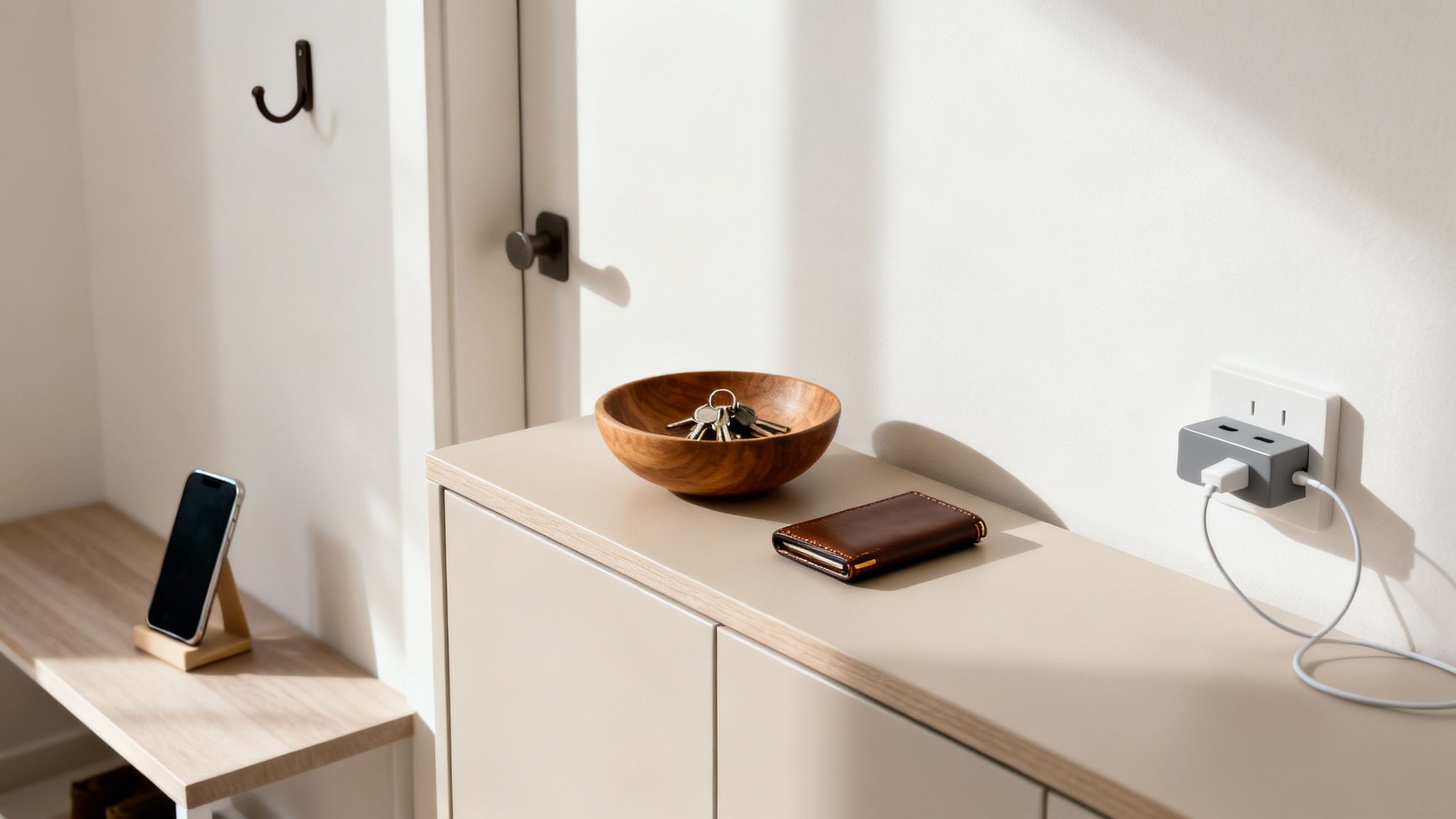
Here it is: the single most powerful strategy to stop losing things is deceptively simple. Give every important item a designated, permanent home.
This isn't about achieving a perfectly minimalist, magazine-worthy space. It’s about creating an external support system for your brain.
When something has a consistent home, you take your working memory out of the equation. Instead of the frantic, "Where did I put my keys?!" you build an automatic habit. "My keys are in the bowl." This frees up precious mental energy for everything else you're juggling.
Identify Your "Most Wanted" List
Before you start assigning homes, let's identify the most frequent fugitives. Take a moment and think about the last week. What have you torn the house apart looking for?
For most of us, a few key culprits are responsible for the daily chaos.
✅ The Usual Suspects Checklist
- Keys (car, house, office)
- Phone
- Wallet or purse
- Glasses or sunglasses
- Headphones or earbuds
- Work badge or ID
- The TV remote
- That one specific charging cable you always need
Once you have your personal list of repeat offenders, you’re ready to build a system to contain them. The goal is to make the right choice—putting something in its home—the easiest possible choice.
Choose Logical and Low-Friction Homes
The best "home" for an item is logical, visible, and requires almost zero effort to use.
If putting your keys away involves opening a drawer, unlocking a box, and hanging them on a specific hook, you're creating friction. Your brain, especially when tired or distracted, will always pick the path of least resistance—which usually means dropping them on the nearest flat surface.
Think about the natural flow of your day. Where do you first walk into your home? Where do you get ready to leave? This is prime real estate for your central hub.
💡 Tip: A central hub is often called a "launch pad." It's a designated spot by the door where you drop essential items the moment you walk in and can grab them without thinking on your way out.
This could be a small table in your entryway, a specific corner of the kitchen counter, or a shelf right by the door. The location matters less than its consistency.
🔬 Scientific Takeaway: A successful organizational system doesn't rely on willpower. It relies on thoughtful design that makes it easier to be organized than disorganized.
For many people with ADHD, creating these external structures is vital. The Inflow app helps you identify your biggest organizational challenges and build these systems step-by-step. If you want to dive deeper into creating a supportive environment, check out our guide with other powerful ADHD disorganization tips.
Putting It Into Practice With Real-World Examples
Let's make this tangible. Here’s how you could assign frictionless homes to your "most wanted" items:
- For Your Keys: Get a decorative bowl or a dedicated tray and put it on your launch pad table. The moment you walk in, your keys go from your hand directly into the bowl. No detours.
- For Your Phone and Wallet: Designate a charging station on your nightstand or desk. This becomes the only place your phone rests when you're not using it. Your wallet can have a dedicated spot right next to it.
- For Your Glasses: If you always take them off to watch TV, put a glasses holder right on the coffee table. If you take them off at night, put one on your bedside table. The home should be where you actually use the item.
- For Kids' Belongings: This same principle is a lifesaver in family life. Using things like clothing name labels for school reinforces this same idea—giving an item a clear identity helps it return to its "home."
By building this simple but reliable system, you're doing more than just organizing your stuff. You're creating a calmer, more predictable environment for your brain.
Have you noticed which items in your own life would benefit most from having a dedicated home?
Build Lasting Habits Without the Struggle
Knowing where your keys should go is one thing. Actually getting them there every single day is a whole different challenge. This is where we close the gap between knowing and doing, building routines that eventually make your new system feel automatic.
The point isn't to be perfect. It's to create habits so simple and ingrained they take almost zero brainpower. We're not relying on willpower; we’re making organization the easiest option available.
Connect New Habits to Old Ones
One of the best ways to build a new routine is a technique from behavioral science called habit stacking. The idea is to piggyback a new habit you want onto a solid, existing habit you already do without thinking.
You don't need to overhaul your entire day. You just have to find the right anchor.
Think about the moment you get home. You probably already have a little sequence you follow on autopilot.
💡 Habit Stacking in Action
- Existing Habit: Kicking off your shoes the second you walk in the door.
- New Habit: Dropping your keys in their designated bowl.
- The Stack: "Right after I kick off my shoes, I will walk to the launch pad and put my keys in the bowl."
By chaining the new action directly to the old one, you’re using momentum you already have. The old habit becomes a trigger for the new one, making it far more likely to stick.
Make Your Cues Impossible to Miss
For a brain that’s easily sidetracked, "out of sight, out of mind" is the law of the land. To work with this, we can create loud, obvious visual cues that grab your attention right when you need the reminder.
You’re essentially outsourcing the job of remembering to your environment.
Here are a few ways to create cues that actually work:
- The Door Check: Slap a neon-pink sticky note on your front door, right at eye level. It could just say, "Keys? Phone? Wallet?" This forces one last check before you leave.
- Color Coding: Make your most-lost items stand out. A bright yellow phone case or a comically large, colorful keychain is a lot harder to leave behind than something small and black.
- Contextual Cues: If you constantly forget your lunch, put your car keys on top of the lunch bag in the fridge the night before. You literally can't leave for work without seeing it.
🔬 Scientific Takeaway: A good cue is designed to interrupt your autopilot. It’s a gentle but firm tap on the shoulder from your environment, reminding you, "Hey, do that thing you wanted to do!"
When You Fall Off Track (Because You Will)
Let's be real: you’re going to have days where you're tired, rushed, or just completely overwhelmed. You’ll leave your keys on the coffee table. This isn't a failure. It's just a data point.
The goal is gentle course correction, not self-criticism. When you spot an item that’s not in its home, the process is simple:
- Acknowledge without judgment: "Oops, there are my keys."
- Perform the action: Immediately walk them over to their designated spot.
That's it. This tiny act of redirection reinforces the habit loop. Beating yourself up just adds a layer of shame that makes you want to avoid the system entirely.
For those looking to build more structure into their day, digging into how to create supportive ADHD routines can be a game-changer.
The Inflow app is actually designed for this exact process. You can set custom reminders—based on time, or even a specific location like when you arrive home—to ping you at just the right moment. These little nudges help reinforce new behaviors until they become second nature.
Have you noticed any existing habits you could "stack" a new one onto?
Mindfulness and Attention Training Techniques
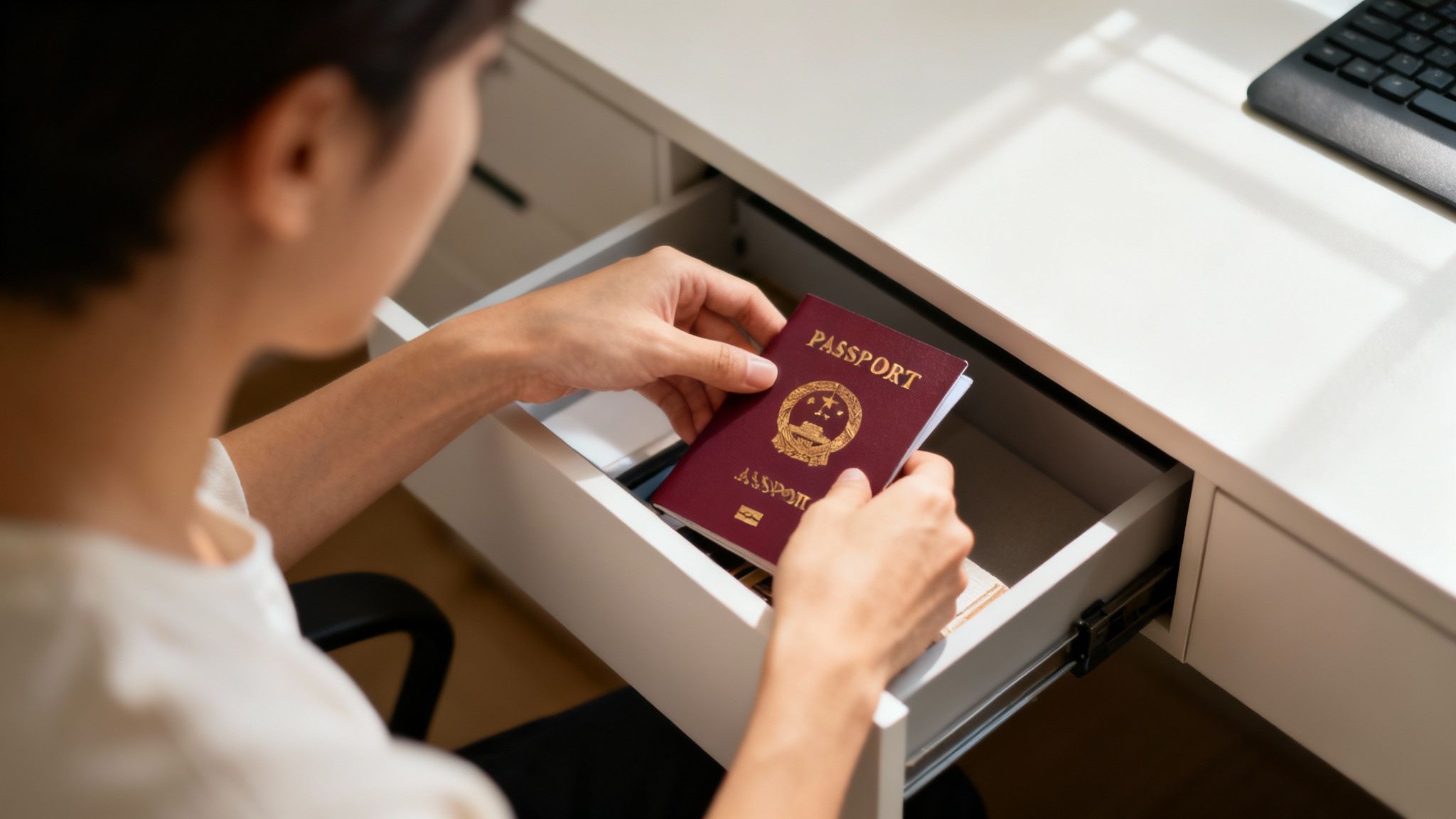
Creating physical "homes" for your stuff is a fantastic external strategy. But what about strengthening the internal muscle—your attention? This is where we shift from organizing our space to training our awareness.
So many of us run on autopilot. Your mind is already on dinner, that email you forgot to send, or what to watch on TV. In that distracted haze, you toss your glasses on the counter, but your brain never actually logs the action.
This is where simple, science-backed attention techniques can make a difference. These are quick, in-the-moment brain hacks designed to snap you out of autopilot just long enough to form a solid memory.
Speak to Your Brain
One of the most powerful and deceptively simple ways to stop losing things is to Say It Out Loud.
The act of verbalizing what you're doing forces you to be present. As you slide your passport into the desk drawer, you say, clearly and deliberately, "I am putting my passport in the top desk drawer."
It might feel a little silly at first, but it works. By speaking, you combine the physical action with an auditory confirmation, creating a much stronger memory trace.
🔬 Scientific Takeaway: Saying something aloud transforms a passive, unconscious action into an active, encoded memory. It's a technique rooted in cognitive behavioral therapy (CBT) that bridges the gap between doing something and remembering you did it.
Take a Mental Snapshot
Another great technique is the mental snapshot. Think of it as a two-second mindfulness exercise that creates a vivid visual memory.
When you put down an important item—say, your work badge on the kitchen counter—just pause. Look directly at the badge in its new spot and take a conscious mental picture. Imagine your brain is a camera clicking and saving that image.
Notice the badge, the countertop it's on, the salt shaker next to it. That brief moment of focused attention is often all it takes to make the memory stick.
💡 Tip: You're not trying to remember one more thing; you're creating a stronger, more detailed memory in the first place. This makes it easier to retrieve later, turning "Where is it?!" into "Ah, I remember that snapshot."
Train Your Focus Muscle
Ultimately, these techniques are exercises in being present. By practicing them consistently, you're actively training your brain to pay better attention. For a deeper dive into managing focus, check out the principles from Nir Eyal's 'Indistractable'. The core idea is building intentionality into your actions—a critical skill for anyone with ADHD.
The Inflow app is full of learning modules on mindfulness and attention that are specifically designed for the ADHD brain. These bite-sized lessons help you understand the science behind your distractions and provide daily exercises to build these mental muscles over time.
Using Technology as Your External Brain
Even the best habits can fail. It's more than okay to outsource some of that mental load to a device that never gets tired or distracted.
Think of it as hiring a smart, tireless assistant for your brain. The goal is to pick a few simple tools that solve your biggest headaches, turning moments of panic into calm control.
Start With the Tools You Already Have
You don’t need to rush out and buy new gadgets. The phone you’re holding is an incredibly powerful tool.
Location-based reminders, for instance, are a game-changer. You can set your phone to nudge you about something at the exact moment you need it.
💡 Simple Reminders You Can Set Right Now:
- "Remind me to grab my lunch from the fridge when I leave home." Your phone will send a notification just as you’re walking out the door.
- "Remind me to pick up the dry cleaning when I leave work." The alert triggers based on your office's location, so you don't drive right past it again.
- "Remind me to pack my gym bag when I arrive home." This helps you remember before you flop on the couch and forget.
These tiny, automated cues act as an external checklist, stopping forgetfulness in its tracks.
Never Lose Your Valuables Again
For those high-stakes items—the ones that trigger a full-blown panic—Bluetooth trackers are your new best friend. Small devices like AirTags or Tiles can be attached to your most important belongings.
When your keys, wallet, or work bag vanish, you can just "ping" the item from your phone. That frantic, heart-pounding search is replaced by simply following a sound.
💡 Tip: Bluetooth trackers are an "insurance policy" for your peace of mind. They’re best for items that are both frequently lost and highly important, like your keys, wallet, or laptop bag.
This kind of tracking technology is incredibly effective. As global air travel has increased, the rate of mishandled luggage has actually gone down, thanks to real-time tracking and electronic tags. You can apply the same principle to your own stuff.
Inflow as Your All-in-One Support System
While simple apps are great, sometimes you need a system designed specifically for the ADHD brain. That's where the Inflow app comes in, acting as a command center for your entire organizational overhaul.
Here’s how Inflow can work as your external brain:
- ✅ Set Recurring Task Reminders: Schedule gentle nudges for your evening tidy-up or to put everything back in its "home" before bed. This is how you reinforce the habits we've been talking about.
- 💡 Use Focus Rooms for Organizing: When you need to finally tackle that clutter pile, Inflow’s Focus Rooms provide a structured, distraction-free space to help you see it through.
- 🔬 Learn About Your Brain: The app’s learning modules offer bite-sized, science-based lessons on executive functions, helping you understand why you lose things and giving you more strategies to cope.
By pairing practical tools with education, Inflow helps you build sustainable skills, not just temporary fixes. For more ideas on how tech can help, check out our guide to the best apps for ADHD.
Common Questions About Losing Things
Navigating the world of organization can bring up a lot of questions. If you’ve been trying to set up systems and still feel like you’re fumbling, you are definitely not alone. Let’s explore some common hurdles.
Is Losing Things Always a Sign of ADHD?
The short answer is no. Everyone misplaces their keys or wallet from time to time—especially when life gets stressful.
The real question is about the pattern. If losing things is a chronic, persistent issue that constantly disrupts your day, it often points to challenges with executive functions. Think of these as your brain's air traffic control system, managing things like working memory, attention, and organization.
While challenges with executive functions are a hallmark of ADHD, they can also be strained by stress, lack of sleep, or anxiety. The frequency and impact on your life are what really matter.
💡 Tip: Instead of focusing on a label, it's more helpful to recognize the pattern. If you see yourself in this struggle, the strategies designed for an ADHD brain—like building external systems—can be a game-changer, diagnosis or not.
What If I Live with Messy People?
It’s one thing to build a system for yourself. It's another to have it derailed by a partner, roommate, or family member who operates in a state of chaos.
The secret here is to focus on what you can actually control. You can’t magically make other people tidy, but you can carve out protected zones for your own essential items.
💡 Strategies for Shared Spaces:
- Create a Personal "No-Fly Zone": Designate one small, specific area that is exclusively for your stuff. It could be a shelf or a particular bowl by the door. Calmly communicate this boundary: "Hey, this bowl is my dedicated spot for my keys and wallet so I don't lose them. Could we try to keep it clear?"
- Double Down on Your Launch Pad: Even in a chaotic home, you can maintain your personal "launch pad." This is your sacred space for everything you need to get out the door.
- Use Lidded Baskets or Boxes: If the visual clutter of other people’s things is a distraction, containers with lids are your best friend. You can keep your items in their designated homes, shielded from the surrounding mess.
Remember, the goal isn't to control their mess, but to create a predictable island of order for your own peace of mind.
I Have Tried Creating Homes for Things but It Never Sticks
This is a really common roadblock, and it's almost never because you're "bad at organizing." When a system of "homes" fails, it's usually for a few specific reasons.
1. The Home is Impractical: The spot you picked creates too much friction. If putting your keys away means opening a closet and hanging them on a tiny hook, your brain will likely skip it. A good home is on the natural path you already travel and requires almost zero extra effort.
2. You Didn't Build the Habit: Creating the "home" is only half the job. You have to consciously practice using it. This is where habit stacking—linking the new action to an old one, like putting your keys in the bowl the second you close the front door—is so powerful.
3. You Expected Perfection: You will forget. The system "sticks" not because you never fail, but because you gently guide yourself back to it every time you notice the mistake. The goal is self-correction, not perfection.
If your system isn’t working, don’t ditch it—troubleshoot it. Is the home in the wrong spot? Do you need a brighter visual cue to remind you?
Getting a handle on losing things is a process of compassionate trial and error. The Inflow app can be a fantastic partner in this, helping you set gentle reminders and offering modules that help you understand your brain's unique wiring. If you're ready to build systems that finally stick, you can start by taking the Inflow quiz to see how it can support your journey.



